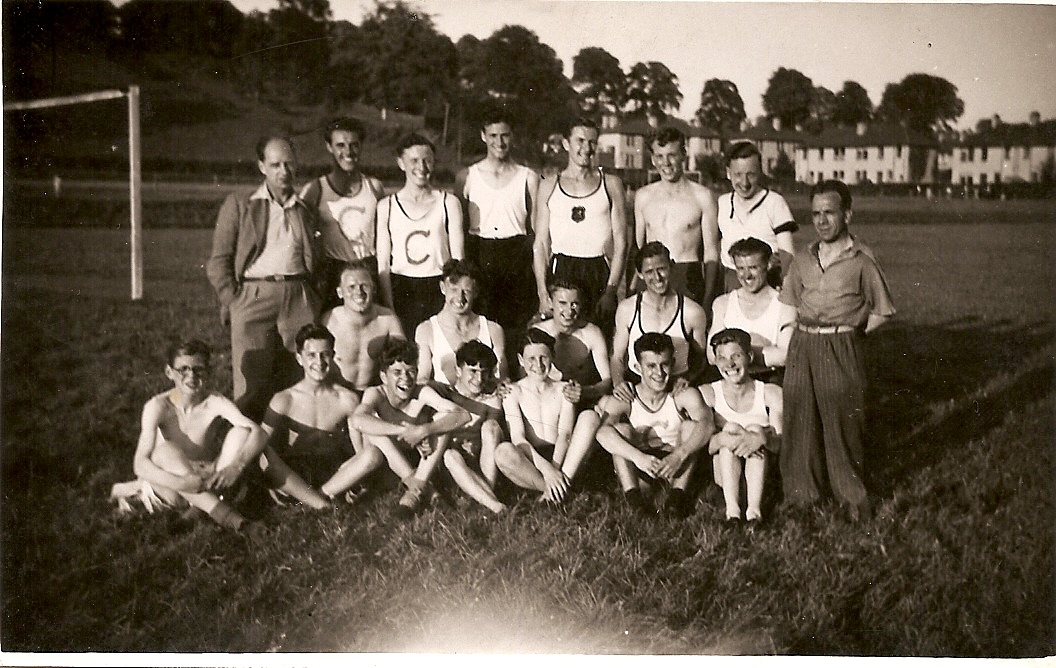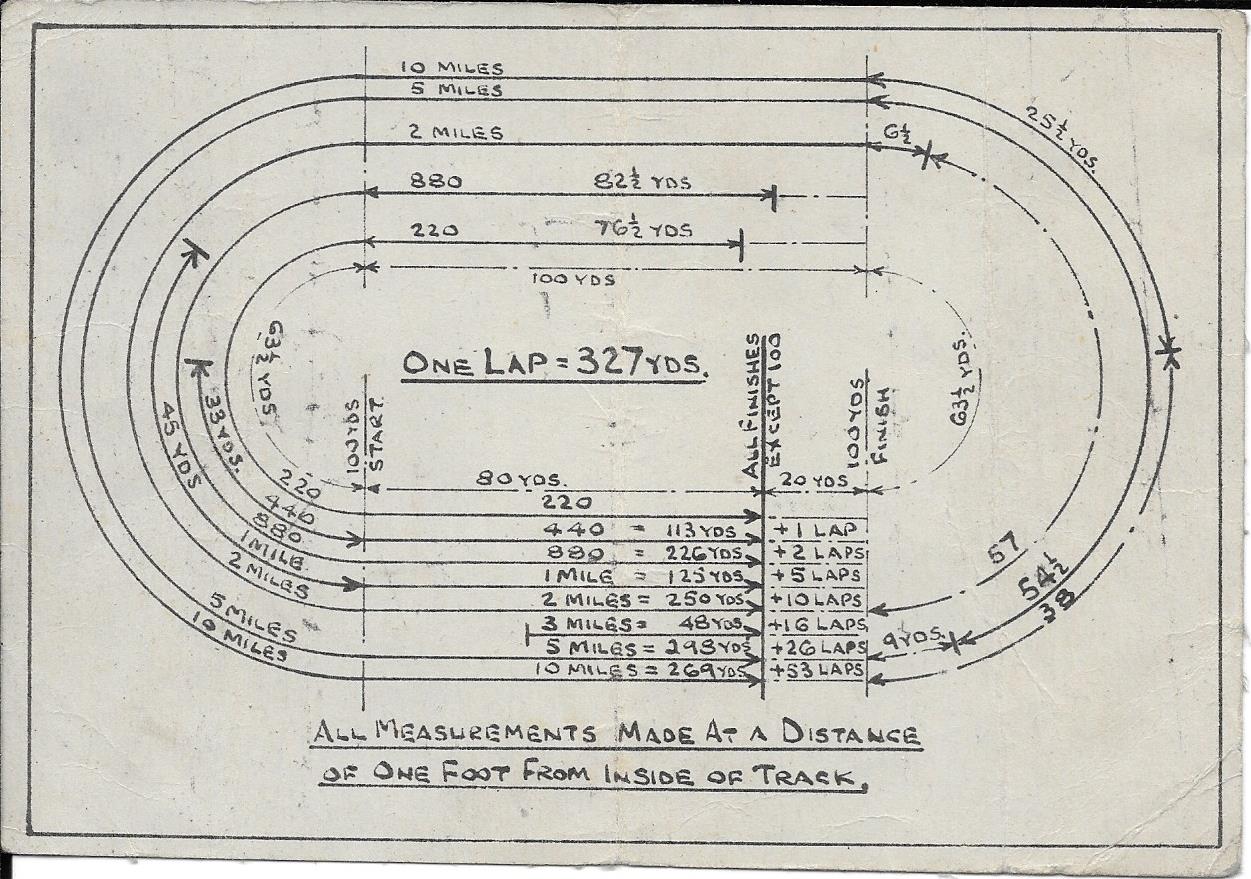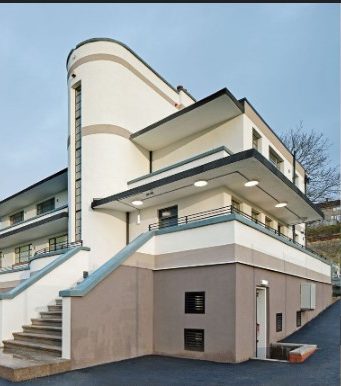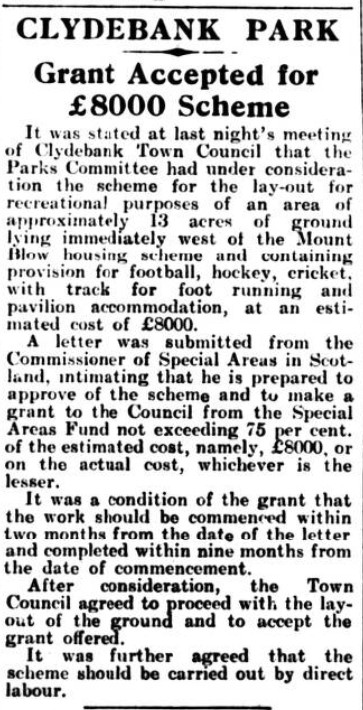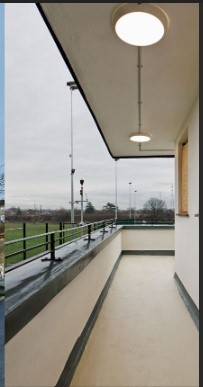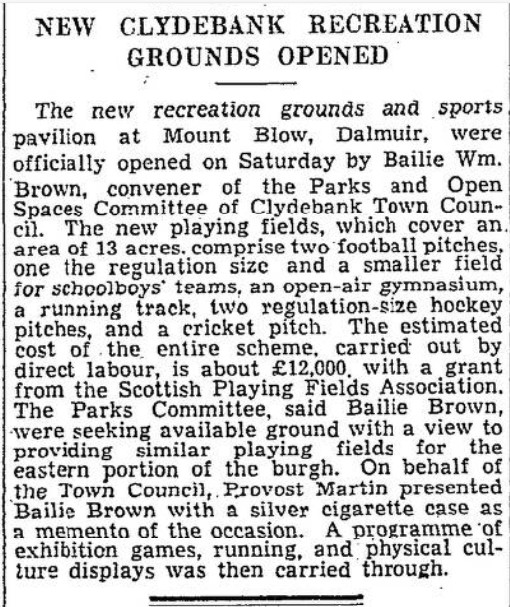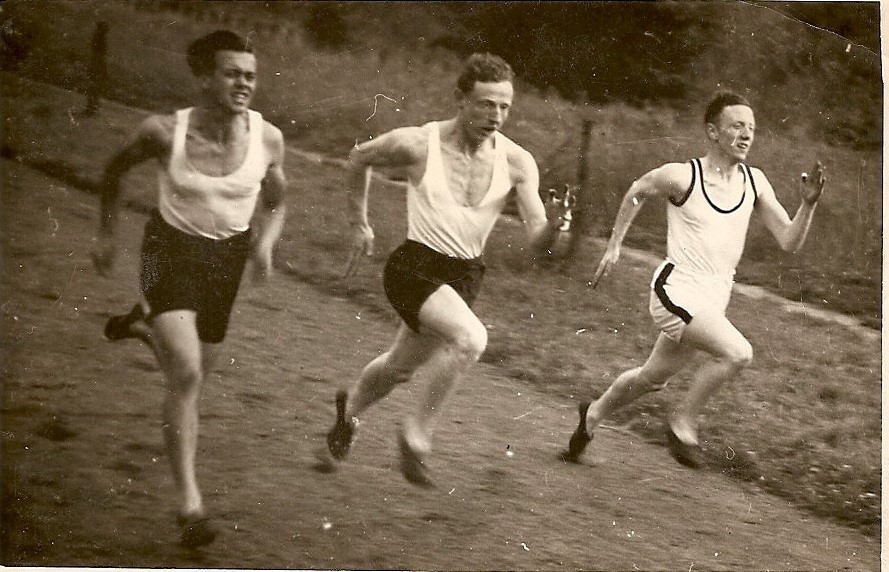A group of Clydesdale Harriers at Mountblow immediately after the second World War.
Mountblow Recreation Ground was a well known facility for athletes and the home of Clydesdale Harriers from its opening in 1937 until the start of the 1960’s. Others came along at times as guests of the club – Tom O’Reilly of Springburn Harriers, Davie Kerr of Garscube Harriers for instance – and when the great Victoria Park team of the 1950’s was at its peak, Andy Forbes led Sunday training sessions there using the 330 yard track and the half mile good grass perimeter. When Ian Logie took up pole vaulting, he had a runway installed and invited David Stevenson, Scottish and British champion in the event, to come and do a session at Mountblow. It was very near the Dalmuir Railway Station and the bus stops on the road outside came from and went to Glasgow and Dumbarton. It was an ideal venue for athletes from all around.
Like all sports facilities be they football pavilions, swimming baths or playing fields at the time, Mountblow had a beautiful art deco pavilion and the layout covered football pitches, hockey pitches, cricket wicket and the athletics track. A recent description of the pavilion, which was a listed building, describes it as follows:
Description
Rare example of Modern Movement sports pavilion surviving largely ulaltered and occupying original recreation ground setting. 2 storey and raised basement, 5 bay rectangular plan on sloping site with cantilevered balcony, oversailing flat roof and tall off-centre curved stair tower with vertical glazing breaking eaves, 2 flights of steps to walkway above basement. Rendered brick. Horizontal pane glazing in metal framed casements, predominately tripartite and bipartite, now with later metal grills to exterior. Later metal roller shutters to entrance doors. INTERIOR. Largely intact floor plan. Ground and first floors similar with concrete floors. Changing rooms lead off central corridor, each floor with bathroom and showers. Some early timber benches and coat hooks. Stair with horizontal metal bannisters.
So much for the building. The running track was 327 yards of red blaes enclosing a small football pitch about which more later. Like many tracks of the period, there were problems in organising meetings with events at standard distances such as 220 yards, 440 yards, 880 yards etc and the club had cards printed as below and all committee members and anyone else involved in organising championships and other meetings.
Diagram of the 330 yard track being used for standard distances such as one mile, three miles, etc showing starting point and number of laps required . Diagram by David Bowman
The grass was very well looked after and a very smooth surface to run on and it was possible to run a straight 300 yards on the level grass. Field events were catered for outside the track because the inside had to be available for football matches. This post deals with how the facility came about.
The picture above from the RIBA Architects magazine, although a modern drawing, is a very good picture of what the Pavilion was like (although the circular lights are an addition).
The “Daily Record” in May 1936 reported on progress on what was a very big undertaking on the part of the local authority.
As the date approached the plans were finalised as noted in the “Clydebank Press” of 27th August, 1937: “It was reported in the Park Committee Minutes, with reference to the official opening of the Pavilion at Mount Blow Recreation Ground, a remit was made with powers to the Recreation Sub-Committee to make the necessary arrangements. Since then the Committee has agreed that the opening should take place on Saturday, 4th September when football and hockey matches, track running, etc, will be carried through after the initial ceremony.”
As far as he clubs were concerned, the Clydesdale Harriers Committee held a supplementary meeting on 2nd September for which the Minute read: “Opening of Mount Blow Stadium. Harriers to stage a One Mile Handicap and two relay races and intending competitors to meet at new pavilion at 2:30 pm, Saturday, 4th.”
The “Clydebank Post” of 3rd September 1937 reported as follows under a heading of ‘NEW RECREATION GROUND. Official Opening Tomorrow Afternoon.’
“Tomorrow (Saturday) is to be a red-letter day for local amateur athletiv enthusiasts, for in the afternoon all roads should lead to Dalmuir to witness the official opening of the burgh’s latest – probably most ambitious recreation scheme, viz, the thirteen acre stretch of new playing fields, situated on ground at Mount Blow, north of the L.N.E. railway. As Baillie Wm. Brown, convener of the Parks and Open Spaces Committee pointed out to a “Press” representative, the new recreation ground, the name of which has yet to be decided, should prove a veritable boon to local football, hockey, cricket and the various athletic clubs, who for a small fee can now enjoy their various sporting encounters in ideal surroundings and under the best possible conditions.
Entering the grounds from Cedar Avenue, in the Mount Blow housing scheme, one is impressed right away with the compact layout of the various pitches, and with the magnificent pavilion of modern design which stands outr majestically on the north side in a central position convenient to those using the various playing fields. The entire scheme which was done by direct labour, has taken about a year to complete – the work being unavoidably retarded at periods owing to the weather. It is a credit to the municipality and a tangible example of the Town Council’s desire to encourage and cater for the amateur sports groups in the town.
Mr A.G. Martin, Burgh Surveyor, and staff, prepared the plans for the layout of the fields as well as designing and supervising the building of the Pavilion by the Works Department, while Mr Thomas MacDonald, Parks Superintendant, supervised the laying out of the pitches in accordance with the plans prepared. The Pavilion, which is as commodious as it is pleasing to the eye, has three separate verandahs from which spectators can
Command a fine view
of all that is taking place within the arenas and on the top of the roof verandah, there is ample space for quite a number of tables where tea and refreshments can be served. The dressing room accommodation within the building is all that a player could wish for. There is, both upstairs and downstairs, ample toilet provision, wash hand basings, etc, light sprays to cool down in, and ten drsssing rooms built to hold a dozen persons. The Pavilion is also equipped with central heating, a kitchenette, and small reception rooms upstairs which leads out to one of the verandahs. The football pitch, north-east of the Pavilion, is one that the most critical soccer enthusiast or player surely cannot find fault with. It is as well conditioned as Rangers Ibrox ground, and the regulation size too, 130 yards by 70 yards. At the northern extremity is situated the most up-to-date and
Best equipped outdoor gymnasium
it is possible to provide at the present time; with horizontal and parallel bars, trapeze, ring and hand swings, five vaulting “bucks” and other such devices for graceful, physical exhibitions and for aiding muscular development. Running parallel with the maximum football pitch and on the railway side, is the minimum football pitch, 100 yards by 50 yards, for use by boys teams, and surrounding it as a well laid out running track, 100 by 50 yards, only 100 yards short of the prescribed quarter-mile regulation one. Some local harriers have seen the running track are a little critical in respect that the bends are perhaps slightly on the sharp side for a big field of runners to take comfortably, but this, we are informed, was unavoidable owing to space limitations. Apart from that it is certainly a fine track. West of the {Pavilion the two maximum sized hockey pitches and a cricket pitch, and the provision of the latter is likely to lead to increased interest in this pastime next summer. One of the features of the carnival will be the football match, Clydebank v Dalmuir. The respective teams are being sponsored by those local doyens of juvenile football, Messrs Mochan (Clydebank) and Robertson (Dalmuir). Both sides will contain the cream of juvenile footballers in the district as many of the players have been excused for the day by their clubs in order to participate in the match. Although only a friendly, both teams will treat the game like a cup tie for the honour of winning the first game on the opening day of the new recreation ground. Dalmuir’s team is likely to be – Curran; Dickson and Friel; Robertson, G Barrie and Graham; Wallace, A Barrie, Smith, Ewart and Henderson.”
One of the ‘verandahs’.
(Illustration also from the RIBA magazine)
The facility was indeed opened on 4th September 1937 and the occasion was well covered by the “Clydebank Press” but not ignored by the wider body of the Press, the “Scotsman” report is below. Note the gift presented to Baillie Brown after the ceremony!
The estimated cost of the new facility was noted above as being £8,000 (£682,957.24 in today’s money). This had risen according to the ‘Scotsman’ article to £12,000. Today’s purchasing power index indicates that that £12,000 would be worth more than £1,024,000 at today’s rates. A slight over-run (£521, 043) but no one was complaining and there were few if any letters to the papers about it.
The report in the “Post” after the opening read as follows.
MOUNT BLOW SPORTS ARENA
OPENING OF NEW RECREATION SCHEME
SIMILAR FACILITIES FOR EAST CLYDEBANK?
The new recreation grounds and sports pavilion at Mount Blow, Dalmuir, estimated to cost about £12,000, were officially opened by Baillie Brown, Parks Committee Convener,on Saturday afternoon, in the presence of a regretably small but interested crowd of citizens. The weather conditions for the occasion were all that could have been desired, and the probable explanation of the poor turnout lay in the number of counter attractionsclashing on the same afternoon. (A description of the new grounds and Pavilion appeared in our last issue).
PROVOST’S REMARKS
Provost Martin, who presided in the opening ceremony said he wanted to welcome all present that afternoon, an afternoon which culminated the great work of bringing to fruition what had been thought of for many years by many members of the Town Council. The Town Council of Clydebank had for a number of years provided open space grounds of one kind or another.
They had various bowling greens, putting greens, tennis courts and the like but they had felt for quite a while they would like a recreation ground that would provide facilities for football, hockey, cricket and so on, and through the assistance of a grant from the Commissioner for Distressed Areas they had been enabled to provide such a recreational area which his friend, Baillie Brown, would open this afternoon. The space provided two football pitches, two hockey pitches, an outdoor gymnasium and cricket pitch and a running track whereby they hoped to be able by that to encourage the local harriers more than they been able to do before. By the opening of htis ground they not only would take their part in the Government Keep Fit but they hoped also to encourage juvenile football clubs and hockey clubs to take a greater interest and build up their interest in sport more than in the past. He then called upon Baillie Brown, Convener of the Parks and Open Spaces Committee – the Committee that had just had the work of preparing for the opening day – to declare open the Pavilion attached to the grounds.
PARK CONVENER’S APPEAL
Baillie Brown said that a great honour had been conferred upon him to open the sports Pavilion on behalf of the citizens of Clydebank. For many years the Parks Committee and Council had been interested in the provision of additional playing fields for their areas, and there had been many complaints that their areas did not have sufficient playing facilities to encourage citizens to take their place in sport alongside those elsewhere. Now they were making every endeavour to see that the youth and citizens of this area would be provided for with sufficient playing facilities to permit them to compete with any other area throughout the country. With football in particular, their juvenile clubs were limited to three spaces and three pitches. That would not apply, he said, after to-day with the additional advantage of the new recreation grounds, which would enable them to compete and play the game with teams from other areas. The Baillie emphasised that while they were opening the new recreation facilities at the extreme west end of the burgh, it was not the intention of the Parks Committee to stop there. They hoped, provided they get the ground, to lay out similar playing fields in the eastern portion of the town. The Baillire, commenting on the provision of the hockey and cricket grounds, pointed out that in the past unless such players were attached to public works amd such like they could not get the facilities for carrying out these games locally and the provision of these two hockey pitches and cricket field would enable such players to compete with others at any particular time now. As far as the Parks Committee were concerned, he assured the citizens that they were
making every endeavour
to try and provide adequate playing facilities locally so that Clydebank would be able to take its part in the sporting sphere, not only were they trying to provide such facilities for the youth but also for the grown upas and old folk as well. They had at present fourteen tennis courts, municipal bowling greens, one 18 hole golf course (one of the best in Scotland), three juvenile pitches then additional two on the new ground, a yachting pond, a swimming pool, seven children’s playgrounds, and three old men’s recreation grounds, the committee were looking out for ground to provide further facilities for the latter. After referring briefly to the committee’s intentions in the near future for the provision of further recreational facilities, the Baillie said he thought it would be seen that the Parks Committee were doing everything possible to enable and encourage citizens to take part in competition for sport held throughout the country, and it was to be hoped that the public would take advantae of these facilities being provided for their benefit and that the various sports organisations in the town would bring honour to Clydebank by winning some of the cups and trophies in competition. Baillie Brown then declared the sports pavilion open amid applause.
A Presentation
On behalf of the Town Council, Provost Martin in a few choice words, presented Baillie Brown with a silver cigarette case and the Baillie trusted that the gift will not be the only silver emblem to be handed over in these present surroundings. Customary votes of thanks were proposed by Councillor Fleming who associated himself with the words of Baillie Brown and said the entire work in connection with the new grounds and pavilion had been done by direct labour. It might be true to say of course that it cost a little more than it would have done under ordinary circumstances, but when one took into consideration the inclement weather of the winter, it would be readily understoodwhy it was not completed sooner. There was one thing they would all agree with and that was that they had made
A splendid job
of it. Councillor Fleming went on to explain the Council were also making enquiries with regard to that portion of ground between Beardmore’s old yard and Brown’s present yard being converted into an accessible open space, with a view that citizens of Clydebank and more especially the old folk, would see it as a rest spot and the elderly could sit there and watch the boats go up and down the river. That was their intention and he thought perhaps Baillie Brown must have forgtten to refer to it. After some further observations anent the new recreation scheme, the Councillor closed by calling for votes of thanks to all who in any way contributed to the success of the official opening.
In the course of the afternoon, the crowd were entertained To displays of racing and football and hockey games and to a display of physical culture by the Junior Instruction Centre Class under Instructor Maxwell.
Sports results.
In an exciting football competition, Duntocher lads beat Dalmuir lads 5 – 3. Barry scoring four and Riley one for Duntocher, and Henderson two and Robertson one for Dalmuir. Singer Ladies hockey XI “A” team won 5 – 1 against Singer “B” team. Scorers: “A” team – Jean Walker(3) and Mary Allan (2); “B” team – Ina Cox. Clydesdale Harriers members supplied plenty of thrilling running on the track. T Luke won the mile off scratch in 5 minutes 1 second, W Howie (100 yds) being second and A Gilmour (100 yds) third. The ladies half-mile was won by Isa Hunter with A. Ritchie and J Ballantine second and third respectively. Clydesdale Harriers Number 1 team beat Clydesdale Harriers Number 2 team in relay racing.”
*
As was noted above, the Harriers were among the very first users of the track. There were only four lanes but the surface was good the huge half-mile perimeter with almost limitless space for jogging, warming up, and good grass track available for sprint drills and strength training using the outside gym made it a superb first-class facility. There were two cricket teams in Clydebank – Singer’s factory had a good team and there was a Clydebank Cricket Club as well. Although Singer’s had a training wicket at Radnor Park, they could use the new one for matches, and the Clydebank team played in a Glasgow League and in the annual Rowan Cup competitions. The athletics fraternity could now hold inter-club matches and even in the late 50’s there were matches against Springburn Harriers and other local clubs, and also in the 50’s Dunbartonshire County Championships were held there. When Ian Logie took up pole vaulting in the early 60’s, the local authority agreed to have a pole vault box installed for the jumpers and Ian had the soft rubber materials for the landing delivered and available for training. He even invited Scottish and British internationalist David Stevenson along for a training session at the venue. The club invited the first Scottish National Coach, Tony Chapman, along and he came and took a session, spoke to some of the senior club members and it was a profitable session all round.
The pavilion was a superb addition to the facilities available – generally the men used the downstairs dressing rooms, the women used those on the first floor. Equipment for high jumping, shot, discus and javelin were kept in the store room below the main first floor with the entry round the side for ease of access. There were four wash hand basins on each floor and a similar number of showers. In addition to the dressing rooms, there were rooms for referees and other officials and for the administrators for any matches held there. The perimeter was almost exactly a half mile which made it useful for training for cross-country running. There was also a steep-ish hill behind the changing room which was also used for training purposes (and its top there was Peggy Barr’s wee shop where lemonade, fruit juice, sweets, cakes, buns and biscuits could be purchased!)
Although the club moved its headquarters for winter to the Bruce Street Baths, runners could train from Mountblow on Saturdays or Sundays on payment of a very small fee. The whole Recreation was well looked after – in the 1950’s and 60’s there were two employees there full time, Ben and Charlie, with Ben the top man. The grass was kept short and in good condition, the fabric of the building was looked after and any club equipment in the store room was safe.
It was also quite close to the Municipal Golf Course – less than half a mile distant along Cedar Road – where the endurance athletes could run longer laps, do hill sessions, run on varying gradients and generally have good hard work outs.
So what happened to Mountblow Recreation Ground? We can have a look at its beginnings first.
Jackie Higginson, Frank McKay and Jimmy Young of Clydesdale Harriers training at Mountblow.
